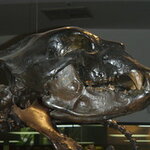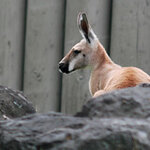Paleontology

Megafauna were part of a cohort of "giant" animals, species of large animals, reptiles, birds and mammals that went extinct during the Pleistocene as our rellies, the homeo sapien sapiens, were spreading out of Africa and southern Asia to populate the globe. Our rise marked the demise of many of the Earth's most interesting beasts. The term, 'megafauna' refers only to those species larger than forty-five kilograms. Many smaller animals who lived along side these giants also disappeared during the Pleistocene, but it is the largest of the lot who get the title and our attention.
While the…
Archaeopteryx (Urvogel ) is the most primitive bird yet discovered. Found in the 1860's, it has since been dated to 150 million years ago but new microscopic imaging of its bone structure says this ancient critter grew less like what we think of as birds and more like dinosaurs.
The bones of more recent bird fossils like Confuciusornis from the Yixian Formation in China which are more recent than Archaeopteryx demonstrate rapid growth more similar to that of modern birds, which means rapid bone growth, considered a prerequisite for flight, was not necessary for taking to the air…
Tyrannosaurus rex has had an interesting few weeks - Raptorex kriegsteini, a man-sized ancestor, was unveiled a few weeks ago and now we find out that Alioramus altai—a horned, long-snouted, gracile cousin of Tyrannosaurus rex—shared the same environment with larger, predatory relatives.
Tyrannosaurs are bipedal predators that lived at the end of the Cretaceous (from 85 million years to approximately 65 million years ago) is currently known from several groups of fossils. One subfamily from North America includes Albertosaurus and Gorgosaurus, while the other subfamily bridges Asia and North…
A 9-foot dinosaur excavated illegally from northeastern China and purchased by a private collector who brought it to the attention of paleontologists (hey, they'll return it after they're done) is about the same weight as a grown human yet had still evolved all the hallmark anatomical features of Tyrannosaurus rex - except 30 million years earlier, according to a study in Science.
Raptorex displays the hallmarks of its famous descendant, Tyrannosaurus rex, like an oversized head, tiny arms and feet well-suited for running. The Raptorex brain cast also shows enlarged olfactory bulbs,…

This guy Spillane has a quarry on his property in Illinois, and for years he's been selling limestone to landscaping companies. And for years, he's been seeing fossils in the rock--particularly, fossil cephalopods.
Then he found one that was five feet long. So he paused his normal operations, and called up this other guy Bluestone. (Can we pause a moment to appreciate how awesome* the surname Bluestone is?) Bluestone worked at the Field Museum and the Shedd Aquarium before creating his own company that "specializes in the planning, designing and building of exhibits at museums, nature centers…

The dinosaurs of Australia disappeared at the end of the Cretaceous, as they did the world over. Their departure marked the end of the supercontinent of Gondwana. By the middle of the Eocene, some fifty-five million years ago, only Australia, Antarctica and South America remained as it straddled the South Pole.
Free of ice and the giant marine and flying reptiles, a new line-up of mammals, flightless birds, crocodiles, snakes and turtles thrived in the warm, wet climate, rapidly adapting and dominating the forests, oceans and skies. New and fanciful creatures, the monotremes, marsupials and…

During the Miocene and Pliocene, 12-1.6 million years ago, a diverse group of extinct proboscideans, elephant-like animals walked the Earth. Most had four tusks and likely a trunk similar to modern elephants. They were beasts of legend, inspiring myths and stories of fanciful creatures to the first humans to encounter them.
One such fellow was Quintus Sertorius, a Roman statesman come general, who grew up in Umbria. Born into a world at war just two years before the Romans sacked Corinth to bring Greece under Roman rule, Quintus lived much of his life as a military man far from his native…

Rare bird, reptile, and mammal tracks have been immortalized in the outcrops of the Chuckanut Formation. Tracks of a type of archaic mammal of the Orders Pantodonta or Dinocerata (blunt foot herbivores), footprints from a small shorebird, and tracks from an early equid or webbed bird track give evidence to the vertebrates that inhabited the swamps, lakes and river ways of the Pacific Northwest 50 million years ago.

Eleven elite paleo enthusiasts were flown into the Tyaughton area near Castle Peak north of Goldbridge 007-style in a shiny new Jet Ranger helicopter. We were interested in the local geology and fossils from the Jurassic-Triassic exposures high in the alpine.
Camping at about 7,500 ft, we were treated to all four seasons and some great collecting over the course of the week. Past trips have included grizzlies at close quarters. This trip we saw fresh tracks and fresh scat, but the bears were actively avoiding our camp, just leaving enough evidence to give us the heads up that this is their…

As kids, we all liked to imagine scenes where big dinosaurs squared off against each other for gigantic battles - if you're young, imagination is like a Transformers movie, but without $100 million for special effects.
Those battles rarely happened, if at all, goes a new hypothesis. Dinosaurs became chickens in evolution (well, maybe) but they were already chickens at heart, say paleontologists at Ludwig-Maximilians-Universität (LMU) in Munich.
Dr. Oliver Rauhut and Dr. David Hone instead surmise that giant carnivores like Tyrannosaurus Rex preyed mainly on juvenile…